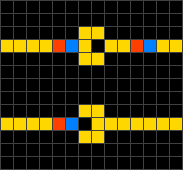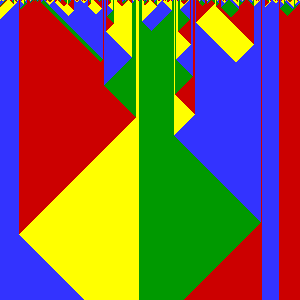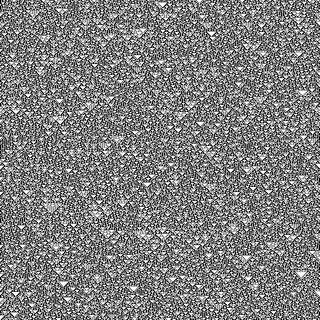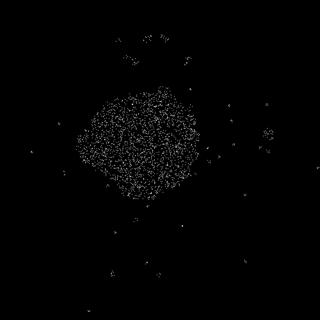
Brian's Brain is a cellular automaton devised by Brian Silverman, which is very similar to his Seeds rule.

Brian's Brain is a cellular automaton devised by Brian Silverman, which is very similar to his Seeds rule.
Brian's Brain consists of an infinite two-dimensional grid of cells, but unlike Seeds, each cell may be in one of three states: on, dying, or off. Each cell is considered to have eight neighbors (the Moore neighborhood), as in Seeds and Conway's Game of Life.
In each time step, a cell turns on if it was off but had exactly two neighbors that were on, just like the birth rule for Seeds. All cells that were "on" go into the "dying" state, which is not counted as an "on" cell in the neighbor count, and prevents any cell from being born there. Cells that were in the dying state go into the off state.
Because of the cellular automaton's name, some websites compare the automaton to a brain and each of its cells to a neuron, which can be in three different states: ready (off), firing (on), and refractory (dying). [1] [2]

The "dying state" cells tend to lead to directional movement, so almost every pattern in Brian's Brain is a spaceship. Many spaceships are rakes, which emit other spaceships. Another result is that many Brian's Brain patterns will explode messily and chaotically, and often will result in or contain great diagonal waves of on and dying cells. For example, a 2×2 block of on cells will result in an ever-expanding diamond consisting of four diagonal waves that move across the plane at the pattern's speed of light.
Nevertheless, oscillators have been constructed in Brian's Brain. An example has just four on cells and four dying cells, and oscillates with period 3. [3]

The Game of Life, also known simply as Life, is a cellular automaton devised by the British mathematician John Horton Conway in 1970. It is a zero-player game, meaning that its evolution is determined by its initial state, requiring no further input. One interacts with the Game of Life by creating an initial configuration and observing how it evolves. It is Turing complete and can simulate a universal constructor or any other Turing machine.

A cellular automaton is a discrete model of computation studied in automata theory. Cellular automata are also called cellular spaces, tessellation automata, homogeneous structures, cellular structures, tessellation structures, and iterative arrays. Cellular automata have found application in various areas, including physics, theoretical biology and microstructure modeling.

Highlife is a cellular automaton similar to Conway's Game of Life. It was devised in 1994 by Nathan Thompson. It is a two-dimensional, two-state cellular automaton in the "Life family" and is described by the rule B36/S23; that is, a cell is born if it has 3 or 6 neighbors and survives if it has 2 or 3 neighbors. Because the rules of HighLife and Conway's Life are similar, many simple patterns in Conway's Life function identically in HighLife. More complicated engineered patterns for one rule, though, typically do not work in the other rule.

In a cellular automaton, a finite pattern is called a spaceship if it reappears after a certain number of generations in the same orientation but in a different position. The smallest such number of generations is called the period of the spaceship.
A cellular automaton (CA) is Life-like if it meets the following criteria:

Seeds is a cellular automaton in the same family as the Game of Life, initially investigated by Brian Silverman and named by Mirek Wójtowicz. It consists of an infinite two-dimensional grid of cells, each of which may be in one of two states: on or off. Each cell is considered to have eight neighbors, as in Life. In each time step, a cell turns on or is "born" if it was off or "dead" but had exactly two neighbors that were on; all other cells turn off. Thus, in the notation describing the family of cellular automata containing Life, it is described by the rule B2/S.

In a cellular automaton, a Garden of Eden is a configuration that has no predecessor. It can be the initial configuration of the automaton but cannot arise in any other way. John Tukey named these configurations after the Garden of Eden in Abrahamic religions, which was created out of nowhere.

Wireworld, alternatively WireWorld, is a cellular automaton first proposed by Brian Silverman in 1987, as part of his program Phantom Fish Tank. It subsequently became more widely known as a result of an article in the "Computer Recreations" column of Scientific American. Wireworld is particularly suited to simulating transistors, and is Turing-complete.

A block cellular automaton or partitioning cellular automaton is a special kind of cellular automaton in which the lattice of cells is divided into non-overlapping blocks and the transition rule is applied to a whole block at a time rather than a single cell. Block cellular automata are useful for simulations of physical quantities, because it is straightforward to choose transition rules that obey physical constraints such as reversibility and conservation laws.

A cyclic cellular automaton is a kind of cellular automaton rule developed by David Griffeath and studied by several other cellular automaton researchers. In this system, each cell remains unchanged until some neighboring cell has a modular value exactly one unit larger than that of the cell itself, at which point it copies its neighbor's value. One-dimensional cyclic cellular automata can be interpreted as systems of interacting particles, while cyclic cellular automata in higher dimensions exhibit complex spiraling behavior.

A rake, in the lexicon of cellular automata, is a type of puffer train, which is an automaton that leaves behind a trail of debris. In the case of a rake, however, the debris left behind is a stream of spaceships, which are automata that "travel" by looping through a short series of iterations and end up in a new location after each cycle returns to the original configuration.

Rule 184 is a one-dimensional binary cellular automaton rule, notable for solving the majority problem as well as for its ability to simultaneously describe several, seemingly quite different, particle systems:

In the mathematical study of cellular automata, Rule 90 is an elementary cellular automaton based on the exclusive or function. It consists of a one-dimensional array of cells, each of which can hold either a 0 or a 1 value. In each time step all values are simultaneously replaced by the exclusive or of their two neighboring values. Martin, Odlyzko & Wolfram (1984) call it "the simplest non-trivial cellular automaton", and it is described extensively in Stephen Wolfram's 2002 book A New Kind of Science.

In Conway's Game of Life and similar cellular automaton rules, a spark is a small collection of live cells that appears at the edge of some larger pattern such as a spaceship or oscillator, then quickly dies off.

Life without Death is a cellular automaton, similar to Conway's Game of Life and other Life-like cellular automaton rules. In this cellular automaton, an initial seed pattern grows according to the same rule as in Conway's Game of Life; however, unlike Life, patterns never shrink. The rule was originally considered by Toffoli & Margolus (1987), who called it "Inkspot"; it has also been called "Flakes". In contrast to the more complex patterns that exist within Conway's Game of Life, Life without Death commonly features still life patterns, in which no change occurs, and ladder patterns, that grow in a straight line.

A reversible cellular automaton is a cellular automaton in which every configuration has a unique predecessor. That is, it is a regular grid of cells, each containing a state drawn from a finite set of states, with a rule for updating all cells simultaneously based on the states of their neighbors, such that the previous state of any cell before an update can be determined uniquely from the updated states of all the cells. The time-reversed dynamics of a reversible cellular automaton can always be described by another cellular automaton rule, possibly on a much larger neighborhood.
The Greenberg–Hastings Cellular Automaton is a three state two dimensional cellular automaton named after James M. Greenberg and Stuart Hastings, designed to model excitable media, One advantage of a CA model is ease of computation. The model can be understood quite well using simple "hand" calculations, not involving a computer. Another advantage is that, at least in this case, one can prove a theorem characterizing those initial conditions which lead to repetitive behavior.

Critters is a reversible block cellular automaton with similar dynamics to Conway's Game of Life, first described by Tommaso Toffoli and Norman Margolus in 1987.

In cellular automata, a replicator is a pattern that produces copies of itself.

The Ulam–Warburton cellular automaton (UWCA) is a 2-dimensional fractal pattern that grows on a regular grid of cells consisting of squares. Starting with one square initially ON and all others OFF, successive iterations are generated by turning ON all squares that share precisely one edge with an ON square. This is the von Neumann neighborhood. The automaton is named after the Polish-American mathematician and scientist Stanislaw Ulam and the Scottish engineer, inventor and amateur mathematician Mike Warburton.